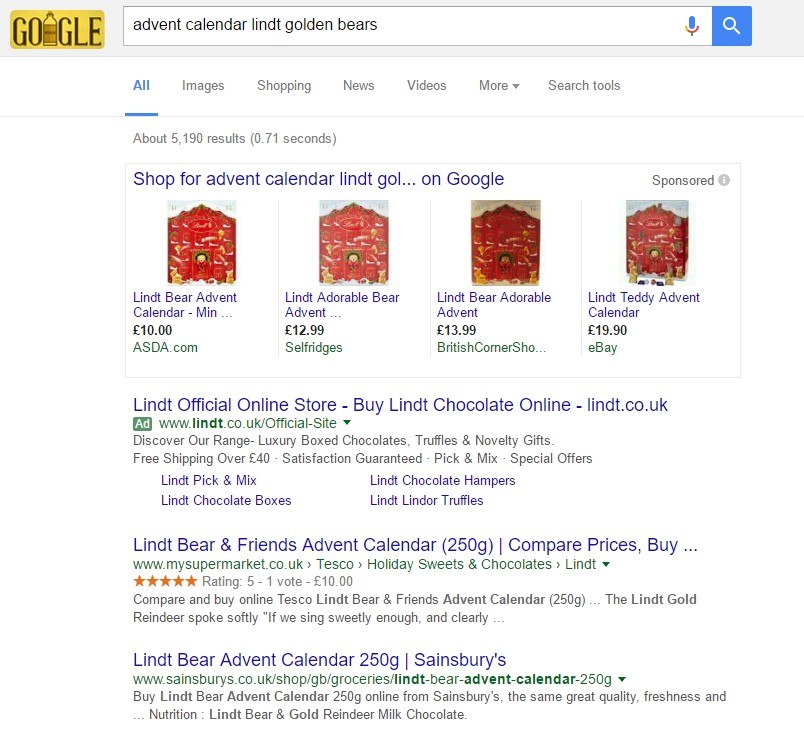Christmas 2016 is coming and Google is getting festive by dramatically increasing the number of Google Shopping ads (previously PLAs or product listing ads) it shows for shopping-based queries. Whether you are an advertiser, or doing your Christmas gift search online, you will soon notice this change.
Some queries are showing up to 15 Google Shopping ads on mobiles and tablets and up to 18 Google Shopping ads on desktop. This is a dramatic increase from the previous format of 6. PLAs have been moved into the right-hand rail on desktop searches, replacing text ads.

The format of the ads has also been changed, with Google Shopping ads appearing in card format, making it easy for the user to browse through and see the relevant information at a glance.
Consumers are becoming more and more savvy when it comes to browsing the internet for the best deals and highest quality products, so this change will be welcomed by many who like to see a series of options from different suppliers before purchasing.
What is Google Shopping?
Google Shopping, previously Google Product Search, has been around since 2002 and developed into the paid format we are now familiar with in 2012. Advertisers can bid for search shopping ads to be shown on the search results page, triggered by shopping queries. The service is profitable for many e-commerce stores as it cuts out the need to compete in the organic search rankings for all the products that they sell.
Google shopping ads show users the name and an image of a product, along with the price and the website and when clicked a user will go straight to the product on the site. From the user perspective, it is a frictionless way to shop online.
How are Google Shopping Ads being delivered?
As with all Google products, Google has been continually testing and updating Google Shopping. During November 2016 Google added a scrolling slider that can show up to 15 options. This appears at the top of the page, completely replacing text ads that previously appeared alongside PLAs. Below the slider, there is also a ‘More on Google’ link that takes users through to the shopping search.
When text ads are still being shown at the top of the page for a shopping query, Google has packed the right-hand rail with Google shopping ads. The ads are shown in the same card format as they are on the slider, keeping with the continuity of the new-look ads.
About a year ago Google made Google Shopping ads larger on mobile and the size of the desktop Google Shopping ads has also been increased in the recent update, maintaining Google’s push for a consistent experience across all platforms.
How to manage your Google Shopping campaigns
Advertisers may need to up their game in order to compete with the increase in Google Shopping ads on search pages. The increase in exposure will lead to greater competition as users take advantage of the opportunity to browse with ease.
Campaign managers will need to spend more time monitoring campaigns and conversions, especially in the run up to Black Friday and Christmas. Although nothing has technically changed to run a successful Google Shopping campaign, advertisers should expect to see fluctuations in results and be prepared to respond to that.
The quality of the feed is more important than ever. Ensure your ads are being shown for all relevant keywords and you have high quality, eye-catching images. Check all your product titles and descriptions. Don’t forget the basics and check that all your ads are approved, so you don’t miss out on any golden opportunities due to an oversight.
Don’t Get Left Behind
As Christmas and Black Friday approach, more and more shopping searches are going to be carried out and, most importantly, more and more purchases are going to be made. Be prepared to increase your budget to match the demand. Your competitors are likely to increase their click budgets in the coming weeks, so ensure you are monitoring your all your budgets and bids.
Now is also a good time to update your mobile strategy, as it is predicted that mobile commerce will make up 50% of all digital commerce in 2017. Thanks to advancements in mobile technology, payment methods and social media channels introducing ‘buy now’ features, consumers now trust mobile commerce, rather than reverting back to desktop for making purchases.
The increase in Google Shopping ads in Google’s search results highlights what an effective tool it is for online retailers. If you, or your client, is selling online but not yet using Google Shopping, then now is the time to implement it and you could still catch the Christmas rush.


